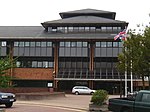Atlantic Wharf
ButetownDistricts of CardiffUse British English from July 2017Wharves in the United Kingdom

Atlantic Wharf (Welsh: Glanfa Iwerydd) is a southern area of the city of Cardiff, Wales. It is primarily an area of new houses and apartments located on the west side of the disused Bute East Dock and to the east of Lloyd George Avenue. It also includes a number of refurbished dock warehouses, modern hotels, the Red Dragon Centre and Cardiff Council's County Hall. Atlantic Wharf lies in the Butetown electoral division of Cardiff and the Cardiff South and Penarth constituency for the UK Parliament and the Senedd.
Excerpt from the Wikipedia article Atlantic Wharf (License: CC BY-SA 3.0, Authors, Images).Atlantic Wharf
Cardiff Butetown
Geographical coordinates (GPS) Address Nearby Places Show on map
Geographical coordinates (GPS)
| Latitude | Longitude |
|---|---|
| N 51.473 ° | E -3.1649 ° |
Address
CF10 4EU Cardiff, Butetown
Wales, United Kingdom
Open on Google Maps









